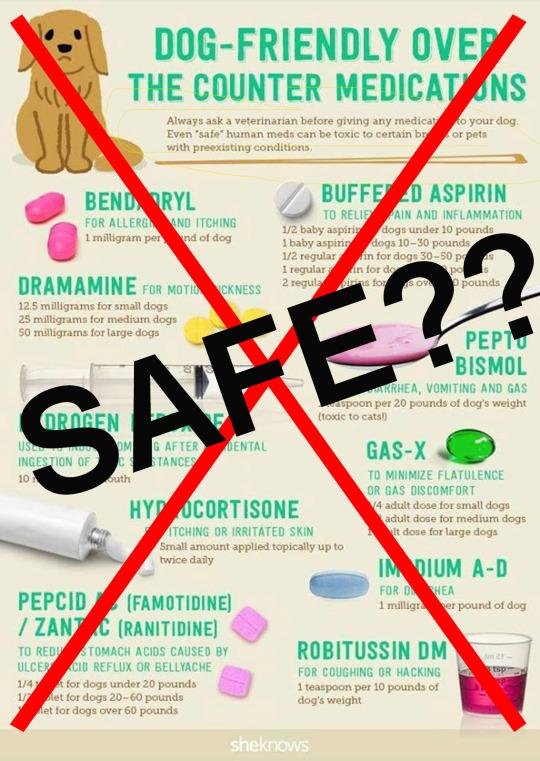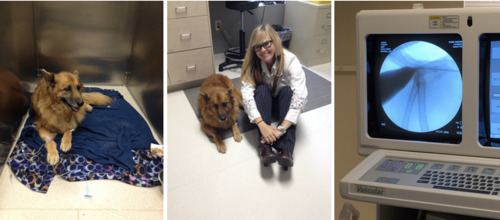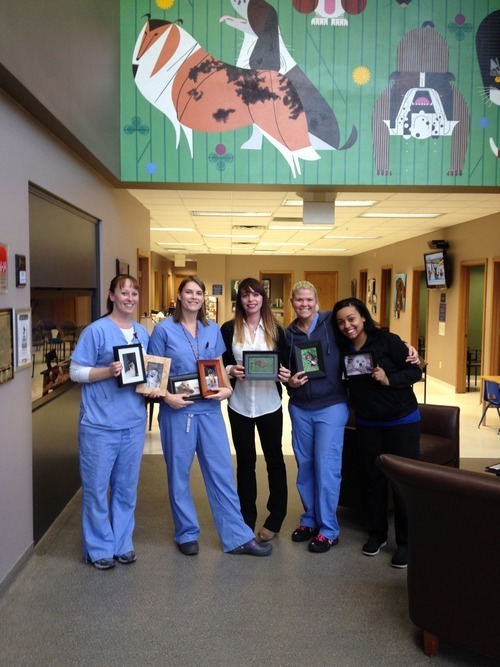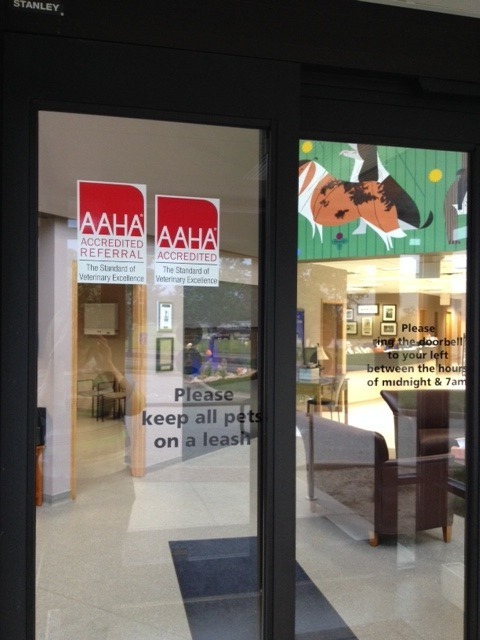Text
Tips for a Pet Safe Holiday Season
It’s the most wonderful time of the year! With holiday festivities upon us, it’s easy to be wrapped up in gift giving, making (and eating) delicious food, traveling and spending time with friends and family. While you’re immersed in the season, don’t forget to keep your pets happy and safe by following these below tips:

Sweet treats and heavy comfort food surround us, but they also smell delicious to your four-legged friend. Not only is chocolate toxic to dogs, but the artificial sweetener xylitol is also toxic to pets. Keep those candy bowls out of paws reach!
Think twice before sharing the fat trimmings from your plate. Fatty foods can be harder to digest for pets than for us. They often over load the pancreas, which can lead to vomiting, diarrhea, and a painful belly. Instead, share your plain turkey meat, green beans, or carrots.
Leftover bones are especially dangerous if ingested. Cooked bones may splinter and cause internal injury, such as puncturing the stomach or intestinal wall. Be sure to secure lids on garbage cans if you have a dog that will go the distance to reach leftovers or scraps. (Let’s be honest, you know they will!)
Shiny tinsel is just too tempting for felines everywhere. They just can’t resist playing with the sparkly strands, but ingesting even one could turn into a surgical emergency if the tinsel gets stuck or wraps around internal organs. Stick to big bows that can’t be easily swallow instead.
Christmas trees should be securely anchored. Make sure you are plugging lights into an outlet that can handle your decorations and turn off lights when you are away. Do not leave lit delicious smelling candles unattended for a curious pet to get too close. House fires are common this time of year so do all you can to minimize the risks.
Hosting a big holiday party for the New Year? Give your pets a quiet space of their own to keep them safe and away from loud noises. Better they enjoy a nap by themselves than be anxious around guests or scared by loud noises.
We hope you enjoy extra snuggles and quality time with your pets during this holiday season. As always, Care Center has doctors and staff available 24 hours a day at our Cincinnati and Dayton hospitals for all pet emergencies.
0 notes
Text
Should You Bring Your Pet to the Vet?
To go to the ER, or not to go to the ER? That is the question! It can be difficult to know which injuries or illnesses can be monitored at home, or if you should bring your pet to your family veterinarian or local pet emergency room ASAP. Below are a few reasons to take them to a doctor sooner, rather than later:

Bleeding
Trauma
Swelling anywhere on the body
Wounds or lacerations
Any type of bite wound
Unable to urinate
Hit by a car
Vomiting or diarrhea
Any toxin consumption
Ingestion of a foreign object
Seizure
Lethargy
Eye problems
Disorientation
Heatstroke
Drowning
Coughing or respiratory distress
Inability to use a limb
Acting painful
Still not sure if you should bring them in? Call your vet and ask! If it is after hours, we are available to speak with you and help you make the decision. Our hospital is fully staffed and ready to help 24/7. We can be reached at 513.530.0911.
*Ready to go a step further?* Click below to be directed to our website and pre-register your pet today. Your information will be kept on file in case you and your pet ever arrive at our doors.
http://carecentervets.com/pre-register
0 notes
Text
A Partner In Your Pet's Healthcare You May Be Missing!

As a responsible pet owner, you care for your pet’s health because they are family. Your furry friend sees their family veterinarian regularly for wellness visits and perhaps the occasional illness. What happens when your pet requires emergency care? What are your options when you regular vet recommends they see a specialist for surgery, advanced diagnostics, or cancer care? As an emergency and specialty hospital, we understand that arriving through our doors can be unplanned and stressful for you, the pet owner. You may not have an ‘emergency pet fund’ set aside for some of these unexpected pet needs. In the human world, insurance helps to offset the costs of unforeseen medical care. Believe it or not, there IS an option for your pet (and your wallet) to have the same assistance in the veterinary world. That option is pet insurance!
At Care Center, we work closely with a pet insurance company called Trupanion. With Trupanion on your side, you can rest assured that 90% of your bill will be covered, anytime you are dealing with non-routine care. For example, Gunny was very ill when he was brought to Care Center’s Internal Medicine department. He was diagnosed with multiple conditions negatively affecting his health and needed extensive treatment throughout his life. Luckily, his Mom had a pet insurance plan for Gunny. Trupanion’s total pay-out for Gunny was nearly $17,000! In her own words, “I am so very thankful that companies like Trupanion exist so that animal lovers like myself can give their fur children the care that they need when they need it.”
Let’s relate Trupanion’s pet insurance to car insurance for a moment. Car insurance doesn’t cover routine oil changes and maintenance, but kicks in when your car is damaged by the elements of nature or you are in an unforeseen accident. In the veterinary world, Trupanion pet insurance works the same way. It doesn’t cover the cost of well visits and vaccines, but helps cover the cost when your pet is ill or injured, both on the small and large scale! “We all have health issues, even if we’re really lucky and they don’t happen until the end of our life. You will never not use it.”
To learn more, check out their website at http://trupanion.com/

There are many different pet insurance businesses around the country. Coverage varies with each company and the plans they offer. Do your research before signing on the dotted line. Look into what is covered, what your deductible will be, etc.
Consider pet insurance BEFORE disaster strikes. Enrolling during a healthy time in your pet’s life will allow you to enjoy the peace of mind that comes with benefits and coverage for the future. You may not be thinking about pet insurance right now, but your future self will thank you for being prepared!
0 notes
Text
Are these “Dog-friendly Over the Counter Medications” really safe?

As a pet owner, you may have seen the above image and content being shared on social media. The recent post titled “Dog-friendly Over the Counter Medications” had over a MILLION shares. However, are these medications actually safe to use at home? Understanding that while these drugs are sometimes used in veterinary medicine, it is always recommended to consult with your family veterinarian, who is familiar with your pet’s medical history, before dosing these OTC medications. Care Center’s Medical Director, and Emergency & Critical Care specialist Marlo Anderson, DVM, DACVECC broke these down a bit further to help steer loving pet owners away from misuse of these medications with their pets.
· Benadryl – (Medication is spelled incorrectly in the original photo, encouraging one to consider the source). While people may experience drowsiness from this medication, that is not usually the case in animals. Some animals may actually become very excited with use of this drug. Benadryl, is usually used for allergic reactions in veterinary medicine. Some allergic reactions can be life-threatening. If you think your pet is having an allergic reaction, we recommend you seek veterinary care from your family veterinarian or call an emergency facility.
· Dramamine- (Dose in photo is not recommended!) This medication is typically used for motion sickness. It is generally regarded as safe *in the correct dosage*, though it is not always very effective.
· Hydrogen Peroxide - Can be given to safely induce vomiting in pets, but you should ALWAYS call and speak with your veterinarian before administering due to adjustment in amounts and consideration on what has been ingested by your pet. Attempting to induce vomiting of certain chemicals or foreign objects can have life-threatening consequences. Foreign objects can get stuck or puncture the esophagus when coming back up. Certain chemicals could also cause terrible burning. If induction of vomiting is recommended, it’s always preferable to do so at the vet with a safer medication and medical staff on stand if needed.
· Hydrocortisone - Many "ithcy" skin issues are actually caused by skin infections. Applying this medication could make a pet much worse. Also if a pet is licking the itchy area, they’re likely to ingest hydrocortisone when topically applied. This should only be used after consulting with your veterinarian and with an e-collar in place to prevent the pet from licking the area.
· Pepcid- This drug is an anti-acid and is often given for stomach upset. Because there can be many reasons why an animal’s stomach could be upset, we recommend you seek veterinarian care if your pet is not eating or drinking, or has vomiting or diarrhea. The drug itself is generally regarded as safe, but should be given under supervision of a veterinarian.
· Buffered Aspirin - This can be extremely dangerous if your pet has a low platelet problem, or is currently on a steroid or anti-inflammatory medication. The combination can cause life-threatening issues. Pets also don’t tolerate aspirin as well as humans do and can easily develop ulcers. Instead of dosing at home, talk to your family vet if you believe your pet is painful. They will help determine the cause and most likely prescribe a safer, pet-friendly medication.
· Pepto-bismol - Vomiting and diarrhea can be a symptom of something worse going on. Pepto-bismol tablets also do not break down easily in the stomach and could be misidentified as foreign objects on x-rays if needed. The medication also contains aspirin and can be unsafe for your pets based on the discussion above. P.S. it’s especially unsafe in cats!
· Gas-X - If you have a large dog, you may have heard the term ‘bloat’. Gas-X is for bloating, right? Sure, but NOT the potentially life-threatening bloat in dogs! GDV (commonly called bloat) describes the stomach flipping internally, cutting off flow of internal juices and blood flow. Giving Gas-X during an emergency can only delay the decision to head to the vet when seconds count. Gas-x should only be given if your veterinarian recommends it after a medical exam has been given to review the severity.
· Imodium A/D - (Dose in photo is not recommended!) This medication may help relieve your pet’s diarrhea for a few days, but if symptoms persist and dosing is continued, it can cause belly cramping. The last thing your pet wants after stomach issues is additional pain. You need to understand what is causing the diarrhea. Giving this medication may only mask your pet’s symptoms while the original problem worsens before you seek veterinary care. #notworthit
· Robitussin DM - While the plain form of this drug can be prescribed for coughing in patients, some formulations with decongestants are HIGHLY toxic to both cats and dogs. Suppressing coughing in a pneumonia or heart failure patient can actually make them worse. The cause of the cough is what needs to be evaluated, as it could be something life-threatening. In the end, your vet will be able to prescribe a safer, pet friendly medication with appropriate dosage.
It is always better to call your veterinarian who understands your pet’s health history. When your regular vet is closed, calling a 24 hour emergency veterinary hospital in your area is recommended. In an emergency situation a doctor or specialist who has never seen your pet is still able to give some advice over the phone in your time of need. In the end, better to treat safely than cause additional problems with your pet’s health.
Original photo source:
https://www.facebook.com/sheknows/photos/a.248019083109.140285.111589138109/10154124163458110/?type=3&theater
4 notes
·
View notes
Text
Your furry companion’s New Year Resolution
They’re going to need your help!

As we welcome in the New Year, you may be setting new fitness goals for yourself and heading to the gym for some exercise away from the cold. Too bad our four-legged family members can’t join us at our favorite fitness center! It is estimated that over half of our country’s dogs and cats are overweight. Never fear, there are things you can do to keep pets active while the dog park is frozen over.
Tip #1: Take your four-legged friend with you to the local pet store. A destination that is probably already on your to-do list, make this a walk indoors for your pet! But fair warning, they may ask to take home a new toy.
Tip #2: Play hide and seek with your canine companion. One person distracts your dog in the sit and stay command with a treat while you run off to hide! Once you’re in position, call from the other room until they find you! Not only is this a calorie burning activity to play indoors, it’s a great brain exercise for them as well.
Tip #3: Have you tried the ever popular laser pointer chase with your feline companion? For some, this game could go on for hours, so make sure you’re not over doing it. Keep the pointer close to your kitty and let them chase with their paws before you have them running up and down the hallways. (You know your kitty best, so if you think the laser may be more stressful than fun, try a wind up mouse toy so they can catch their prey at the end of their hunt!)
Tip #4: Chasing bubbles may seem like a summer game, but it can be a great indoor activity as well! What a fun way to spend time with your canine (AND feline!) friends while they burn a few extra calories. Don’t believe us? Watch Audrey the Chihuahua and we bet you’ll be convinced.
https://www.youtube.com/watch?v=s84dBopsIe4
Tip #5: Even old dogs can learn new tricks! If your pet has the basics down-pat, think of all the other fun tricks you can teach. How about playing dead, roll over, speak, turn in circles, shake, bring in the paper, or catch a frisbee. Get creative! Check out this super smart pup if you need some inspiration.
https://www.youtube.com/watch?v=qe15LxQCLcA
Tip #6: Up for a little friendly competition? Consider a pet fitness tracker. Similar to the fitness watches for humans, the canine versions generally clip onto your pet’s collar. You can find a tracker that sends stats of your dog’s activity levels, compares their fitness to other canines of their breed, and even tracks their location right on your phone! To find one that’s right for your pet, follow the link:
http://www.caninejournal.com/dog-activity-monitor/
We hope you have fun with these tips! Remember, you pets (and your veterinarian) will thank you for helping them stay trim through these sluggish winter months.
0 notes
Text
They need blood too!

Did you know dogs can be blood donors just like people? This is something many people have never heard of nor thought about before. There are many different cases in the world of veterinary medicine where blood products are used to help pets after trauma or dealing with disease. The Care Center Animal Blood Bank is a non-profit organization which collects, prepares, packages, and stores blood for use in our own hospital, as well as for hospitals around the country. Here are some FAQs regarding all things canine blood donation!
1. Is my dog eligible to become a blood donor?
Ideal candidates are young (1-6 years old) dogs, who are very sociable and friendly. Blood donors should not have any serious health issues and should not be on medication (thyroid medication and certain others are OK). We also require that blood donor dogs are up to date on their recommended vaccines, and have monthly flea control and heartworm medication. Since the blood donation process takes about 10-15 minutes, blood donor dogs should be comfortable laying on their side with gentle restraint for this period of time.
2. Do dogs have different blood types than people?
Yes, dogs actually have several different blood types. Their blood groups are called DEA groups (dog erythrocyte antigen) based on the types of proteins on their red blood cells. The most important blood type is DEA 1.1, and many donor dogs are negative for DEA 1.1 (about 50% of dogs).
3. How much blood can my dog donate? How often can he/she donate blood?
Dogs can donate a full pint of blood, just like a person. Our donor dogs need to be at least 50 pounds to donate blood. Healthy dogs can regenerate their blood cells and be ready to donate blood every 4-6 weeks, however we only ask our blood donors to come in every 3-4 months.
4. What happens to the blood after a blood donation?
The collected blood is separated into components- packed red blood cells and fresh plasma (the water component of the blood). By separating the blood into its components, we are able to help more dogs with every transfusion. Each blood donation is processed into 2 units of red blood cells and 2 units of plasma- potentially saving the lives of 4 other dogs.
5. What happens to my dog when I drop him off for a blood donation?
The first thing we do is take a tiny blood sample from the back leg to make sure your dog’s blood count is high enough to donate. The minimum PCV (red blood cell count) is 45% for most dogs, and 55% for greyhounds. Then we take the dogs into the blood bank area, where they get treats and are allowed to play with toys and become familiar with the room. Blood donations happen with the dog laying on their side on a padded bed, and only takes about 10-15 minutes. The blood donation is collected from one of the large veins in the neck, and you may notice a small shaved spot in your dog’s fur (under his collar). Once the donation is complete, the blood donor dog gets to play some more, and is given a can of food, treats, and lots of love!
6. How will my dog act after a blood donation?
Most dogs will display no obvious effects of donating blood. Unlike humans, dogs have a mobile reservoir of red blood cells in their spleen, and can replace 1/3 of the donated blood immediately. They will regenerate the rest of the blood cells within a couple of days. Occasionally dogs will be tired after coming home, but most dogs are ready to eat, play, and exercise as soon as they get home.
7. Will my dog be sedated for blood donation?
No, we do not routinely sedate dogs for blood donation. Most dogs are remarkably tolerant of the procedure, especially once they learn there’s food and snacks afterwards!
8. What benefits do blood donors receive?
With each blood donation, your dog receives a large bag of Hill’s Science Diet dogfood. They get a free emergency office call yearly (tests and hospitalization not included) as well as comprehensive lab testing performed annually. In addition, should your dog ever develop an illness and need a blood transfusion, we will provide the blood products at no charge, up to the number of units your dog has donated.
9. How do I schedule a blood donation appointment?
We will contact you every 3-4 months to bring your dog in for a donation.
10. What if I have additional questions?
Please feel free to contact us at 513-530-0911, or email at: [email protected]
1 note
·
View note
Text
Pet First Aid Kit

During these active summer months,accidents can happen. Consider taking time to make a small pet first-aid kit to keep in your car. Having these items handy can help you treat your pet or provide enough aid until you can reach a veterinary hospital. Emergencies happen, now you can be prepared.
Bandage supplies- cotton gauze wrap, vet wrap, clean sock, medical tape
Q-tips/tongue depressors
Gloves
Scissors
Tweezers
Gauze/cotton balls
Clean towels or blanket
Bottled water
Quick stop- used to stop bleeding from cut or torn toenails
Hydrogen peroxide
Antibiotic ointment, anti-bacterial soap, saline solution (same as used in human first aid)
Muzzle/E-collar- Even the friendliest of pets can get confused and frightened when injured, which may cause them to lash out in pain. Protect yourself and them.
Thermometer- insert the tip just past the rectum. (Normal K9 temp is 100-102.5 degrees. Normal feline temp is 99.5-102.5 degrees.)
Don't forget Emergency phone numbers!
CARE Center 513.530.0911
ASPCA Animal Poison Control 888.426.4435
Hopefully you won't have a pet emergency, but we'll be here 24/7 if you do!
0 notes
Text
Canine Influenza : What You Need to Look For
Canine Influenza (CIV) isn't something to overlook. It can affect your dog's life just as much as that lackluster “winter flu" affects ours. Did you know there are multiple strains of the Flu and that these strains constantly mutate? It’s almost like the virus itself has a plan of its own. In this particular case, it does. It spreads from dog to dog.
Here’s a brief history of Canine Influenza, some important facts and how it became what it is today:
In 2004, one of the first cases of CIV was discovered at a Florida Greyhound racing track by Dr. Cynda Crawford. Since then, the original strain (H3N8) has been seen in approximately 40 states. Like most virus’s, it has mutated to avoid detection. Fast forward to the spring of this year, and an outbreak of a similar CIV (H3N2) occurred in Chicago. Since then, CIV cases have trickled all throughout the Midwest. CIV has not been detected in any humans thus far. If you remain cautious and catch the symptoms early, your furry friend won’t be in any real danger.
Here’s some symptoms to look for if your dog may have CIV:
· Coughing
· Exercise intolerance
· Nasal discharge
· Loss-of appetite
· Fever
· Lethargy
· Dyspnea
No need to panic, but if you have suspicion your dog might have some of these symptoms, think smart and quickly contact your local vet or Care Center. In some cases, late diagnoses have acquired respiratory problems and even contracted pneumonia. Similar to the “human flu,” this sickness weakens the immune system causing it to be more susceptible to other forms of illness.
Information gathered from www.vetgirlontherun.com
0 notes
Text
Happy American Heart Month!
We are dedicating February to bringing you extra special news on our cardiovascular team!
First, why don’t you meet our wonderful cardiologists?

This is Dr. Megan McLane, DVM, DACVIM -

Dr. McLane grew up in Illinois but has also lived in Nevada and New Jersey. After receiving her Bachelor of Science degree in Biology from Monmouth University in New Jersey, she traveled to the Northwest to obtain her DVM at Oregon State University. She then spent four years at California Animal Hospital Veterinary Specialty Group completing both her small animal internship and cardiology residency. Dr. McLane has a special interest in management of the critical cardiac patient and long term care of all forms of heart disease. She is also excited to help set up the interventional cardiology unit at Care Center with Dr. Schuckman. When not working, she enjoys painting, hiking, and discovering new cuisines. Dr. McLane is very excited to return to the Midwest and be closer to her family, in addition to exploring all that Cincinnati has to offer.

And, this is Dr. Maggie Schuckman, DVM, DACVIM

Dr. Schuckman is a Cincinnati native, originally from Pleasant Ridge. She obtained both her BS and DVM from The Ohio State University. Dr. Schuckman completed a one-year rotating internship in small animal medicine and surgery at Michigan Veterinary Specialists in 2009. With a love for veterinary medicine and cardiology Dr. Schuckman applied and was accepted into the cardiology residency program at University of Guelph. During her residency she researched the utility of the new echocardiographic imaging modality called speckle tracking. She also received advanced training in interventional cardiology and is pleased to offer minimally invasive procedures to correct Bradyarrhythmias as well as some congenital heart disorders. Dr. Schuckman has two cats, Tabs and Toby, and a rambunctious Golden Retriever and blood donor, Maverick. In her downtime, she enjoys sports, especially volleyball, and relaxing at her local dog park.

Looking for ways to improve your pet’s cardiovascular health? Care Center doctors recommend a normal exercise routine with your pets. For dogs we would recommend normal walks. You may already be doing this with your dog to take it to the bathroom, but many people actually feel like they don’t have time to walk Fido once or twice a day. In reality, you have a lot of time in between work and family. Waking up even 15 minutes earlier in the morning can help you to take your pup for a walk and it helps you to wake up as well. It is a great bonding ritual. Nightly walks are also an easy way to add more exercise for your dog. Regular walks also increase positive feelings in your animal, so this is a win-win-win situation! For cats we recommend lots of play time. This can include cat toys like mice, balls, or feathery wands, as well as tall cat houses or even laser beams. If you find that your cat really likes to start playing with their toys right when you go to bed, try playing with them 20 or so minutes before you go to sleep. Exercising with your cat before your bedtime can help your nighttime from being interrupted by their prime playtime.
Happy Heart Month from Care Center!
0 notes
Text
New Year's Resolutions with your Pets

It’s always in style to make some resolutions for the New Year, isn’t it? The most popular ones seem to include cutting back on greasy foods, working out, maybe sleeping more, or drinking less alcohol, but have you ever thought to include your pet in your resolution decision making? We have! Including your pet into your New Year’s Resolutions can increase the chances of success, build a stronger relationship between you and your pet, give you some accountability, and create new lasting habits.
Some ideas for Pet New Year’s Resolutions include:
Cut back on and eventually stop free feeding! Making a specific schedule can help your pet’s belly, help you feel more sane, and cut back on the amount of food you’re feeding your pet. More isn’t always better!
Go on regular walks each day. A small change of walking for just ten minutes a day can really make an impact on your relationship!
Training, training, training! It’s never too late to train your dog, and it can actually be a lot of fun! (Look for a later blog post for tips on training!)
DIY projects for making toys on a budget! Ever notice how cats would much rather play for toilet paper rolls than those fancy mice you buy? Create a toy for your furry friend and watch how happy your furry friend is with her new toys!
What are your New Year's Resolutions?
1 note
·
View note
Text
Urinary Block in 14 year old collie mix leads to Stent Procedure

Meet Phoenix, the beautiful 14 year old collie mix who visited our Cincinnati emergency room after gaining a referral to our offices from her veterinarian Stephanie Ogburn of Trenton Animal Hospital. Phoenix’s owner was concerned when her dog stopped eating and could barely urinate. The diagnosis? Proliferative polypoid urethritis.
First, Phoenix saw Marlo Anderson, DVM, DACVECC, for an ultrasound to find severe bilateral renal pylectasia and bilateral ureteral dilation, as well as a distended urinary bladder. Then Phoenix went over to Beth McElravy, DVM, DACVIM, who performed a cytoscopy to find spider webbing bands of pale-pink to white tissue in the vestibule, fluffy white tissue along the urethra, and a firm pale white mass obstructing the urethra. After that finding, Crystal Doyle, DVM, DACVIM and Eric Row, DVM placed a stent where Phoenix’s urinary tract was blocked.

Phoenix’s owner Sherry said that while it is scary to not know exactly what is happening to your animal while they are sick, Care Center truly helped her to feel more comfortable and helped her stay at ease throughout the entire visit. Sherry explained that Dr. Doyle was incredibly patient and explained the stent procedure to her calmly and in a caring manner, allowing her to ask questions. Sherry was so happy that Care Center’s staff was knowledgable and even though they were very busy, they did everything above and beyond to make her feel more comfortable, even sending her progress photos of Phoenix overnight.
Urinary blocks can be benign or malignant. Stents are great long-term treatment options for benign blockages and they can also be a way for families to have some extra quality time with a pet who may have a more serious blockage. Thanks to Care Center’s cutting-edge technology, Phoenix was released from her procedure quickly and was home urinating quickly and easily. Blockages are common, and we are proud to say that our staff’s education in combination with our state of the art equipment helped treat this common ailment. We are so very happy that we could help Phoenix and that she is continuing to live a happy, healthy life.
2 notes
·
View notes
Text
Turning Thanksgiving Leftovers into Animal Friendly Treats

Are you feeling up to giving into those puppy eyes this holiday season or do you have a new animal that you don’t want to exclude from Thanksgiving deliciousness? We suggest turning some of your delicacies into animal friendly meals!
This can be relatively easy to do, you just have to know what items to avoid, which items are pet friendly, and keep a few key things in mind! Make sure you know your pet’s belly. If your little one doesn’t normally eat human food, don’t give them too much at once. If this is the first time you’re cooking for little pumpkin, go for a small portion at first and see how your pet reacts to it. Also keep these thoughts in mind if your pet has had a sensitive stomach in the past. Remember to avoid chocolate, grapes or raisins, onions, garlic, leeks, scallions, macadamia nuts, and sugar substitutes. Keep in mind that some recipes (like stuffing) may seem okay for your dog, but many stuffing recipes call for onions or other toxic ingredients.

Straightforward ingredients are the way to go with animal recipes--keep it natural and keep it simple. It’s safe to stick with the following:
Turkey is a-okay, just remember to remove any excess fat and skin as well as bones.
Potatoes are also great, but make sure any mashed potato recipes don’t include cheeses, onion, or gravy.
Cranberry sauce is a nice way to add color and flavor but only in smaller amounts because of excessive sugar contents.
Green beans are a great nutritious option for a pet recipe and are highly recommended!
Rachael Ray has an awesome recipe for Leftover Thanksgiving Hash that includes leftover sweet potato, turkey, stuffing (without onions/garlic) or a piece of chopped toast, sage, and cranberry sauce. According to her site, dogs and cats like this recipe! It sure looks pretty tasty, doesn’t it?
Another recipe we found is for Thanksgiving Turkey Nibblers and only includes one ingredient--you guessed it! The cook recommends using dark meat because it is what most people have leftover. Just pop it in your oven for a few hours to dehydrate and watch your cat eat it up after it cools!
Check out these other recipes for more ideas-- Pumpkin Ice Cream and Turkey & Rice Meals!
Simple is as simple does, and we like simple! Check out Google for more recipes if you become adventurous or find out that you are the next Top Pet Chef! Have any recipes you’ve tried and want to share with us? Send them our way, we’d love to see!
Sources: PetMD, Rachael Ray, Love To Know Cats
1 note
·
View note
Text
Thankful
We are really feeling thankful this holiday season and wanted to share some of our stories with you.

"I am thankful for Yzma, my getting bigger everyday kitten who is happy to lay in the sun and always wants to cuddle. I am especially grateful for Sochi – the perfect dog! She is always there to greet me with those big brown eyes, her one floppy ear and hugs every time I need it. Also, thankful for Dr. McElravy for keeping her healthy. I love my girls." – Jessica
"I am thankful for my Chihuahua Dakota. He is a great snuggler and keeps us warm during the winter holiday season. I am also thankful for my “kitty” for keeping our mole population under control." – Taylor
"I am beyond thankful for my two precious Yorkies, Gizzmoe and Libbie. Gizzmoe is such a wonderful alarm clock in the morning and is always so happy. Libbie fills my heart with love and little loving kisses. My life is complete when they are around and they make my heart so happy." – Katryna
"I am grateful for my two Care Center rescues, Shinobi and Emmi. Shinobi is truly my “soul mate” dog. He is my protector, my friend, and my first child. Miss Emmi is my tri-pod cat that doesn’t let her lifestyle modification keep her down. I am also grateful for my warm weather hunter, Markus. He keeps the rodent and stray cat population in check, and he is one amazing snuggler." – Rochelle
"My family this year added a new kitty Monroe, to our family. He was left on the side of the road in a litter of black kittens around Halloween. The first time I met him he walked up to the cage and stared at me with his little yellow eyes, I held him in my arms and it was love at first site. Growing up always with dogs in my family, I quickly became a cat lover the minute Monroe had me in his site. I love how he stretches in the morning and paws me with his little paws until I scoop him up in my arms and hug him, I love how he plays with my young daughter so patiently never hurting a hair on her head, and how he always chooses my lap to spend his time. Whenever I bring him to work he is loved on by everyone. I am thankful that I found him and he found me." - Stephanie
During the holidays it is important to remember all of the many things we have to be thankful for. Here are a few things Care Center technicians in Cincinnati and Dayton said they are thankful for:
"Being able to help to relieve the pain and discomfort of animals coming to us in need."– Vanessa, Surgery
"Advancement in veterinary medicine so we can better help our patients, referring veterinarians and their pet owners." -Stacey, Emergency
"Ability to have so much variety in my day and job, it is great to be able to have many different things to see and do each day." – Kevin, Internal Medicine
"Having a positive hospital work environment even though we see many sad cases, and sick patients. When one of us has a bad day we go out of our way to provide support for each other." – Amanda, Emergency
"I am thankful for nice cats that don’t try to bite and scratch me, and for sloppy dog kisses!" – Kara, Cardiology
"Great owners and patients that love animals and caring for them as much as we do." – Chrissy, Cardiology
"Very thankful for our Client Services Coordinators, they have a tough job sometimes and they always maintain a positive disposition." -Troy, Emergency
"Knowing that the work that we do benefits the animals and their owners, and especially thankful for getting to see patients go home with their owners!" - Amy, Surgery
"Being able to be a supervisor over such a great team of people that help each other out when needed." – Jen, Internal Medicine
In addition to all of those lovely thankful messages, we are also thankful for you. Thank you for supporting us and for being a part of our family!
0 notes
Text
Care Center’s Board-Certified Veterinary Specialists: Your Pet’s “Super” Specialist

Has your vet said that you need to see a specialist at Care Center? He or she is referring to our board-certified veterinary specialists.
These professionals are veterinarians who have chosen to specialize in a clinical field of veterinary medicine, such as cardiology and oncology. (For a list of our specialists please visit http://www.carecentervets.com/specialty.)
A Veterinary Specialist may be consulted when your pet’s condition requires specialized care above and beyond what a regular veterinarian can provide. Many Veterinary Specialists require a referral in order to be seen. After treatment, the Veterinary Specialist may stay in close contact with your referring veterinarian to provide ongoing treatment suggestions and advice.

The process for becoming a Veterinary Specialist is rigorous and requires extensive post-graduate training and experience. Typically, before taking the final step of a certification exam, a veterinarian must complete an internship (1 year) followed by a residency training program (usually 2-3 years) under the supervision of veterinarians who are board-certified in that specialty.
Many certification programs also require some training in different areas of veterinary medicine to ensure that they have a comprehensive knowledge of closely related areas. For example, to become board-certified in veterinary surgery, an individual must also complete the following during the 3 or more years of their veterinary surgical residency:
At least 80 hours of training with a Board-certified veterinary anesthesiologist
At least 80 hours with a board-certified veterinary radiologist
At least 80 hours with a board-certified veterinary internal medicine specialist, and;
At least 80 hours with a board-certified veterinary pathologist
If your vet says that you need to see a specialist call the Care Center and schedule an appointment with one of our specialists, if you’re not sure which specialist you need to see, our Referral Coordinator can help you.
1 note
·
View note
Text
Fluoroscopy…Your Pet in Motion

Typical x-rays produce a static image that helps us diagnose issues with your pet’s bones and soft tissues. The image can also tell us if your pet has ingested a foreign object.
However, sometimes we need to see the inside of your pet, in motion. That’s where Fluoroscopy (aka “moving x-ray”) comes into play.
This diagnostic imaging tool uses x-rays to generate a real-time moving image of the patient on a computer screen (such as the above image)
The different ways we use this medical device at Care Center include:
Noninvasively and painlessly diagnosing a specific issue or disease, such as dynamic tracheal (windpipe) collapse.
Aiding in minimally invasive cardiac procedures including pacemaker placement, correction of patent ductus arteriosus (a type of congenital heart disease in dogs), and balloon valvuloplasty for pulmonic stenosis (a congenital heart defect).
Guiding the specialist as they insert catheters, stents, or other devices inside the body, and the surgical correction of minor fractions.
Sometimes we use this device during surgery to direct our efforts, as show below (the computer image with the two circles on it).

As you can see, fluoroscopy is a highly valuable tool that literally gives us insights into your pet, helping us better care for and diagnose your beloved companion.
0 notes
Text
Your Emergency Animal Hospital Visit “Take List”

If you and your pet need to visit Care Center, use this list as a handy reminder for what to bring along.
First, please know that any and all information that you can give to our veterinarians could help us find a diagnosis for your pet. All of this information can be useful if an emergency happens.
Bring with you:
1) Your pet’s medical and vaccination records.
2) Any recent blood-work results or x-rays done at your veterinarian’s office. That information may help us diagnose a potential problem. We may also use the information as a benchmark for current blood-work or x-rays.
3) If your pet possibly ingested something toxic, bring any and all packaging with you, or bring the actual item or plant that they may have eaten. This helps the veterinarian decide which tests should be run to diagnose your pet.
To make it easier on yourself, keep all of your pet’s medical records together in one spot, such as binder or folder. That way you or someone else can find it and grab it before heading out the door.

Also be ready to answer the following questions:
1) Are your pet’s vaccinations current? We need to know, because this may protect them from contagious diseases.
2) What is their medical history? Do they have any allergies or current health problems?
3) Has your pet been eating and acting normal? Have they been defecating and urinating regularly?

We understand you and your family may be upset or worried about your pet when you arrive. Bringing their medical information and staying aware of their health can help you and us take the absolute best care of your beloved companions.
0 notes
Text
Offering You & Your Pets the Highest Standard of Care - AAHA Accreditation in Traditional & Referral Categories

Did you know that accreditation is not required for animal hospitals? Given that, how can you determine the quality of care that we could provide to your pet and to our referring veterinarians? Choosing who provides medical treatment for your pet in emergency and critical situations is a tough and important decision.
Our decision to earn the American Animal Hospital Association’s (AAHA) accreditation was driven by our desire to truly care for your pets, and to assure you and our referring vets that each animal is getting the absolute best care possible.
After a four month accreditation process, Care Center is proud to announce that our Cincinnati and Dayton locations have earned AAHA’s highest honors for both Traditional and Referral Accreditation. The Traditional accreditation covers the hospital side, including day to day patient care and procedures. The Referral accreditation covers our specialties including Internal Medicine, Cardiology, Surgery, and Emergency/Critical Care.

Currently, we are the only veterinary hospitals in the region with the distinction of dual-accreditation. AAHA-accredited hospitals are considered the best in the industry and are consistently at the forefront of advanced veterinary medicine. As such, the AAHA accreditation reflects and validates our commitment to the high level of consistent care and medicine that we practice. That same level of care and advanced medicine, allows us to offer a range of care and treatment options to you and our referring vets.
“Roof to Basement” Evaluation
A 900 point onsite evaluation was a crucial step of the accreditation process. The auditor assessed Care Center’s knowledge, standards, protocols and processes from front desk staff and client services to the board certified specialists. Specific examples of areas covered included:
Isolation room cleaning protocol
Medical equipment usage
New patient intake process
Continuous education for referring vets
Disaster recovery plan, and staff and patient evacuation plans
Inventory and equipment management
X-ray safety protocols
Housekeeping and maintenance
As an accredited hospital we now have access to a toolbox of resources helping us both maintain and foster an even higher standard of care. The wealth of information includes veterinarian and technician education, marketing support and programs for leadership, mentoring, and team building.

Care Center’s partners are very proud of the Cincinnati and Dayton staff for this accomplishment, and we look forward to celebrating internally!
For more information about Care Center’s Accreditation read our press release.
For more information about AAHA, please visit: www.healthypet.com.
0 notes